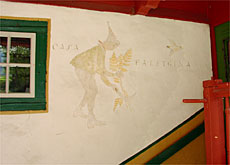The bell tolls for Carigiet on centenary

Alois Carigiet was best known as the illustrator of many children's books, including "A Bell for Ursli".
Dale Bechtel travelled through Carigiet’s home region and discovered a rich tapestry of colours, many of which made it on to the artist’s canvas.
A native of canton Graubünden, Carigiet was born in on August 30, 1902. When he died in 1985, he left behind a legacy making him one of the country’s greatest artists, illustrators and graphic designers of the 20th century.
He’s remembered mostly though for his children’s books, especially “A Bell for Ursli” which among Swiss children’s literature ranks only behind Heidi in popularity.
(The book is available in English from Orell Füssli publishers in Zurich)
It is considered a classic in Japan and is on recommended reading lists for young children in many countries in the English-speaking world.
Bell-ringing
Fans of the book often travel to the Lower Engadine because this is where the story of Ursli and the bell-ringing tradition unfolds. And indeed, many people associate Carigiet with this particular valley in the eastern corner of Switzerland.
But the Lower Engadine and its people and their customs were foreign to Carigiet who was born at the other end of Graubünden in the Surselva valley – same canton, different world.
He grew up in the village of Trun and returned there to spend the last years of his life after making a name for himself as a graphic artist in Zurich.
Frescoed houses
The Lower Engadine is known for its broad frescoed houses and wooden fountains. In Surselva, the villages are less tidy and their tall wooden houses less ornate. The fountains are made of stone.
“In the book’s last illustration, Carigiet shows Ursli’s family eating soup, bread and cheese, but they should have been eating traditional Engadine dishes made from chestnuts.
He wasn’t able to make that observation,” says Beat Stutzer, the curator of Graubünden’s Fine Arts Museum, who has put together a retrospective on the artist’s early years.
Carigiet had to redo the illustration in order to match the text written by the Engadine author, Selina Chönz.
She set the book, written originally in Romansh, in her hometown of Guarda in the Engadine.
One of the houses in the village square is even named “Uorsin” – the Romansh name for Ursli.
Prying tourists
It is not unusual for prying tourists to try to steal a glance behind the front doors of the houses in the square to see if there are any signs of the boy hero, or the giant cowbell he fetches to take pride of place in the “Chalandamarz” bell-ringing procession.
But Carigiet’s more prolific side comes to life in and around his place of birth. This is where he spent the last 20 years of his life, depicting rural scenes in the Surselva, which he found had changed little since his childhood.
His house and atelier sits on a mountain slope overlooking the village, surrounded by a picket fence, designed by the artist himself.
Pointy fence posts
“It was typical of him. He had it made to his specifications,” says Gieri Schmed, an artist in his own right, who assisted Carigiet after his return to Trun.
“These pointy fence posts [are typical]. In all of his paintings, you see pointy fence posts,” Schmed continues.
But not only are the fence posts pointy, Carigiet’s paintings portray everything as long and thin. His peasants are tall and skinny, his buildings are high and narrow, his trees scrawny and brittle.
Whenever Carigiet travelled through the Surselva, he had his sketchbook to hand. “He always wore a green jacket with a hood, and carried a very large sack,” says Schmed.
“He probably had it specially made in order to hold his sketchbook and a couple of pencils – that was all he needed. He never even used an eraser.”
Rural imagery
He was a prolific painter and his pictures of rural mountain life in the Surselva from the 1940s until his death in the 1980s is still the image many people have of Graubünden.
“Even today, many people see Graubünden through the eyes of Carigiet,” explains Stutzer. “While vacationing in Graubünden they often look beyond the influences of the modern world to see the idyllic side portrayed by Carigiet.”
Carigiet also got his way in “A Bell for Ursli”. He contrasted the squat Engadine houses with his trademark skinny trees; thin crescent moons and lanky villagers.
He even gave the hero, Ursli, a pointy cap, shaped just like the tops of the fence posts around his house in Trun.
by Dale Bechtel
Alois Carigiet was born on August 30, 1902
as graphic artist, designed posters for 1939 national exhibition
“A Bell for Ursli” was published in 1945
Canton Graubünden is celebrating the centenary of the birth of painter, graphic artist and illustrator Alois Carigiet. Although he is considered one of the great Swiss artists of the 20th century, he was best known for the children’s book, “A Bell for Ursli”, which he illustrated.
The book is second only to Heidi in popularity among Swiss children’s literature.
Carigiet is often associated with the Lower Engadine region where the book was set, even though the culture was very different from the villages of the Surselva Valley where he grew up and spent the last 20 years of his life.

In compliance with the JTI standards
More: SWI swissinfo.ch certified by the Journalism Trust Initiative










You can find an overview of ongoing debates with our journalists here . Please join us!
If you want to start a conversation about a topic raised in this article or want to report factual errors, email us at english@swissinfo.ch.